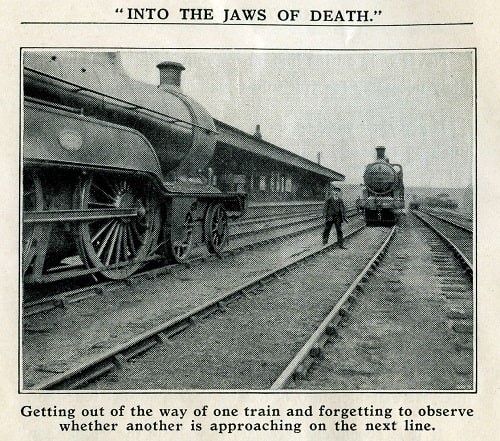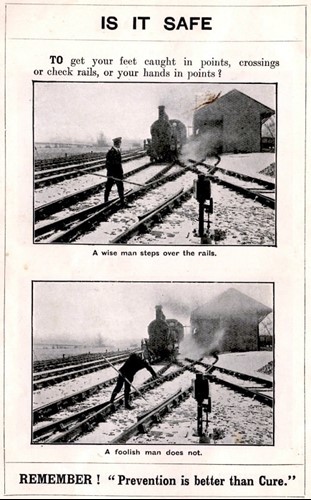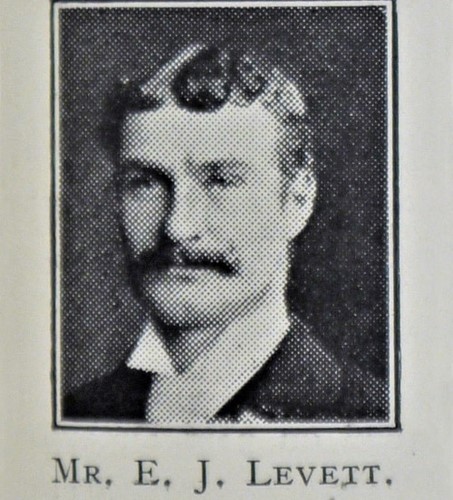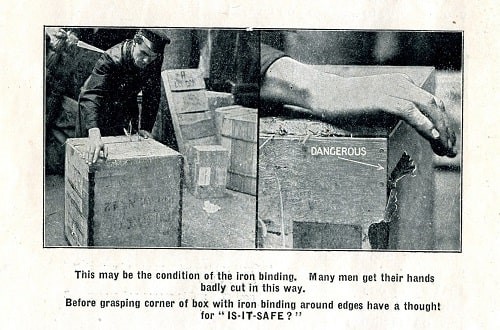A new online archive of accidents to Britain’s railway workers between 1889 and 1939 seeks to remember those injured and killed – but also helps us to learn lessons about ways of changing and improving workplace safety culture, attitudes and practices.
Features
Learning from the past
Over the last 66 years, the British Safety Council has advocated for workplace and other safety, trying to reduce harm and improve wellbeing. While the nature of hazards and needs have changed over the years, in 2023 the BSC’s role and mission is just as important as ever. There remains a lot to be done.
It’s also worth remembering an era before the BSC, when things were a lot worse. The ‘Railway Work, Life & Death’ research and online archive project does exactly that, focusing on the railway industry and staff accidents before 1939. Whereas now any deaths on the railways are regarded as unacceptable, for the period of our project multiple hundreds of deaths in any given year was simply part of the price of working the railways. In fact, our research has revealed how over 21,000 railway employees were injured or killed at work in Britain and Ireland between 1900 and 1939 – and what the major trade union of the time did to look after some of them and their families.
 Some dangers were specific to the railways – including being run down by moving trains, as seen in this early 1930s posed safety image. Courtesy Railway Work, Life & Death.
Some dangers were specific to the railways – including being run down by moving trains, as seen in this early 1930s posed safety image. Courtesy Railway Work, Life & Death.
Knowing the problem
Part of any solution is knowing the problem. Whilst before 1939 the railway industry in Britain and Ireland might have had very mixed success in improving worker safety, one thing that can be said for it is that it did know what was happening in terms of accidents. In 1892, the state appointed inspectors to investigate staff accidents; between 1900 and 1939 their reports form a record of around 21,000 cases where we know more about what happened and why.
The problem for us in the 21st century was, these reports weren’t well-known, easily accessible or indexed. Finding something you might be interested in was chance at best. The wealth of detail in the reports meant there was missed potential for all sorts of people – whether looking at current health and safety, family history research or so much more.
That’s where the ‘Railway Work, Life & Death’ project came in. It was set up in 2016 to try to make these records more easily accessible. We’ve been working with small teams of volunteers – without whom it wouldn’t be possible, so full credit to them – at each of the project partners: the University of Portsmouth, the National Railway Museum and the Modern Records Centre at the University of Warwick. The volunteers are transcribing the records, which we’re then making available free, via our project website.
These records tell us what was happening, how the accident took place, where, when and any changes recommended as a result of the investigation. Last year, we added a further 17,000 cases to the database, to complete the run of state accident investigations. This year we’ve added around 25,000 cases drawn from records of the Amalgamated Society of Railway Servants/ National Union of Railwaymen (now the RMT Union). However, this focus on large numbers risks obscuring another important reason the project has been started: remembering the individuals.
 1920s posed safety image of the type of accident suffered by Ernest Levett in 1904. Courtesy Railway Work, Life & Death.
1920s posed safety image of the type of accident suffered by Ernest Levett in 1904. Courtesy Railway Work, Life & Death.
People, not numbers
We think this is something that will strike a chord within the BSC and its members, now as much as was the case in 1957 when the health and safety charity was established. Each of the nearly 50,000 cases in our database was an individual – with a family, friends and belonging to their community. The focus on numbers might be shocking – but, sadly, it is easy to dismiss. The numbers are both too large to understand and abstract, unreal.
 Ernest Levett, pictured in the Great Eastern Railway Magazine, after his death in December 1921. Courtesy Railway Work, Life & Death.
Ernest Levett, pictured in the Great Eastern Railway Magazine, after his death in December 1921. Courtesy Railway Work, Life & Death.
But let us put it another way: thanks to the original records and our project work, we can see the people who had accidents. Men like Ernest John Levett (pictured above), who we know from the project dataset had an accident at Bury St Edmunds in 1904, resulting in a bruised foot. Inconsequential, perhaps, though very typical of most cases in that it was relatively minor (though could have been a lot worse). We also know from other evidence that Levett went on to have another accident, in December 1921 at Ipswich, which led to his death. He left a widow and four children, aged between nine and 24. Through our project work, we see not only the accidents, but the individuals.
Sadly, with so many cases to choose from, it’s possible to find someone or a location or a type of work or accident to fit almost any parameters. Clearly many of these are specific to the rail industry – typically to do with moving trains. But some cases might have happened anywhere: sprains and strains; slips, trips and falls; manual handling and the like. It’s also interesting to note that we see safety issues arising from contracting work out – very much a problem in many industries in 2023.
Why bother looking back?
It’s crucial to know our past – it explains how we’ve got to the present. The BSC demonstrated the importance of this point when it rediscovered its archive: it invested serious time and money in digitising the material and making it publicly and freely available as part of its 60th anniversary celebrations in 2017. Whilst the particular circumstances of the past were specific to that point in time, understanding that and being able to see similarities and comparisons in the present can help us think about how we’re addressing health and safety issues now.
 1914 posed safety image, relating to manual handling. Courtesy Railway Work, Life & Death.
1914 posed safety image, relating to manual handling. Courtesy Railway Work, Life & Death.
Our project work shows that, for the rail industry, many of today’s problems are not new: track worker safety, for example, and the importance of safe routes to worksites. The cases in the project database shed light on safety cultures, which, whilst different now – thankfully, given at the time the immediate assumption seems to have been worker ‘carelessness’ was the root cause of most accidents – can give rise to significant conversations about how health and safety is understood.
We might be able to use these changes and continuities to help us think about health and safety now, and to suggest how we might change both attitudes and practices. Experience shows that the rail industry is both interested in its past and engaged with our project – but also that these broad principles might usefully be applied across other workplaces, too.
So, we invite you to explore this fascinating resource and to carry on thinking about what we might learn from the past. What we’ve done with ‘Railway Work, Life & Death’ offers great opportunities – and ultimately, of course, it will help us remember some of the individuals who were involved in accidents, who might otherwise all too easily be forgotten.
About the author
Dr Mike Esbester is senior lecturer in history at the University of Portsmouth, and his research focuses on the history of safety, risk and accident prevention in modern Britain. He worked with the BSC on preserving the BSC archive and authoring Transformative Propaganda: Opening the Archives of the British Safety Council. Mike co-leads the ‘Railway Work, Life & Death’ project, alongside colleagues at the National Railway Museum and Modern Records Centre at the University of Warwick. As well as the free database, the project also includes a regularly updated blog, and welcomes guest contributions.
Explore the ‘Railway Work, Life & Death’ project:
railwayaccidents.port.ac.uk
@RWLDproject
facebook.com/Railway-Work-Life-Death
Explore the history and digital archive of the BSC:
https://www.britsafe.org/about-us/introducing-british-safety-council/celebrating-60-years-of-british-safety-council
FEATURES

Sedentary working and how to combat the ‘sitting disease’
By Gavin Bradley, Active Working on 05 April 2024
Prolonged and excessive sitting poses a major risk to our health, but the Get Britain Standing campaign and On Your Feet Britain Day on 25 April are a great way of encouraging workers to sit less and move more.

Company culture and wellbeing: a crucial link
By Bex Moorhouse, Invigorate Spaces on 05 April 2024
Investing in measures to support worker wellbeing will be ineffective unless the company culture genuinely incorporates values like teamwork, involvement, flexibility and innovation.

Office design and culture: happier and healthier staff – or the opposite?
By Guy Osmond, Osmond Ergonomics on 03 April 2024
Applying ergonomic principles to workstation set-ups and ensuring the physical environment supports neurodivergent people are just some of the ways of creating an office where everyone can thrive, but a supportive and positive organisational culture is vital too.


